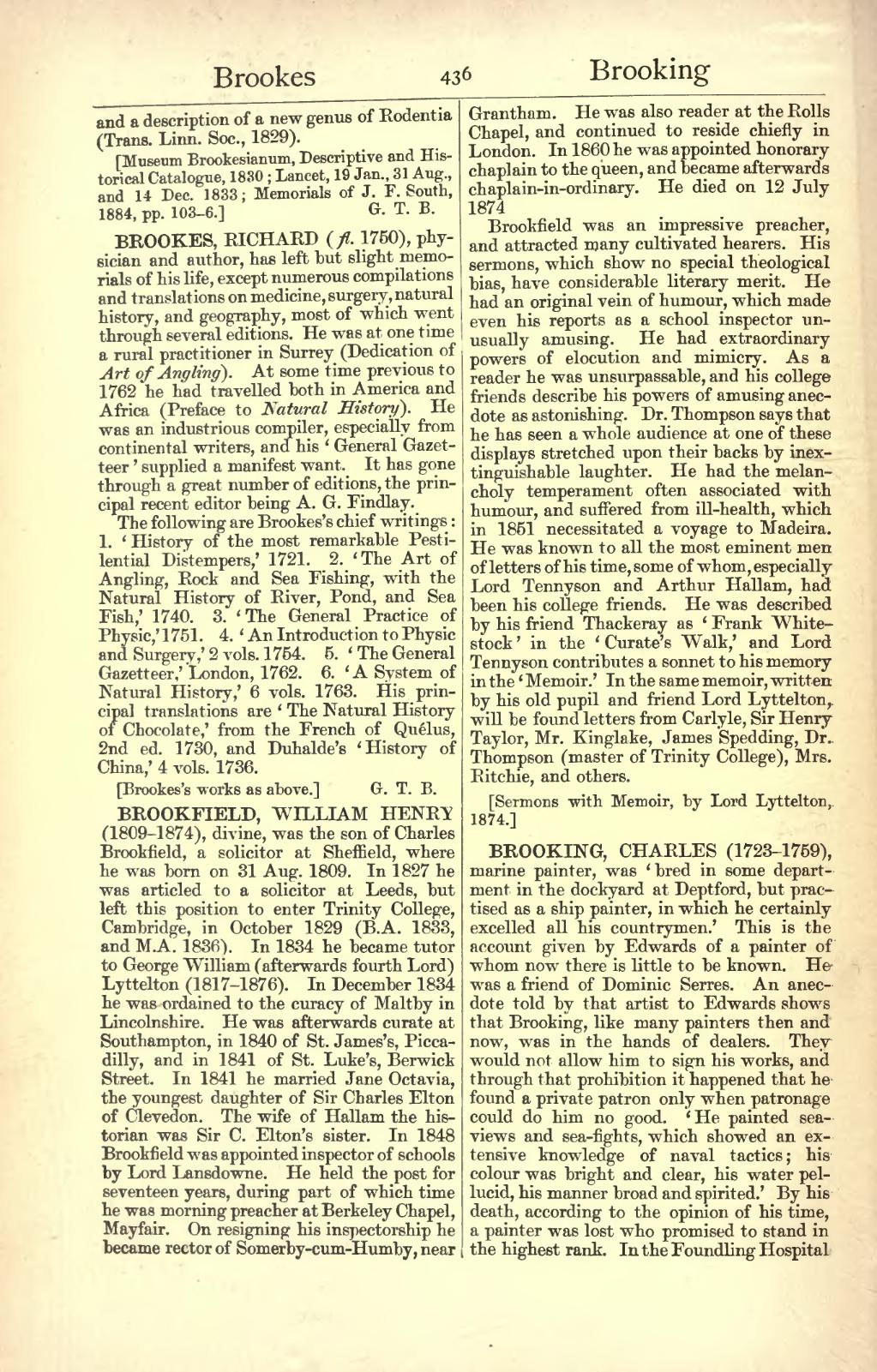and a description of a new genus of Rodentia (Trans. Linn. Soc., 1829).
[Museum Brookesianum, Descriptive and Historical Catalogue, 1830 ; Lancet, 19 Jan., 31 Aug., and 14 Dec. 1833; Memorials of J. F. South, 1884, pp. 103-6.]
BROOKES, RICHARD (fl. 1750), physician and author, has left but slight memorials of his life, except numerous compilations and translations on medicine, surgery, natural history, and geography, most of which went through several editions. He was at one time a rural practitioner in Surrey (Dedication of Art of Angling). At some time previous to 1762 he had travelled both in America and Africa (Preface to Natural History). He was an industrious compiler, especially from continental writers, and his 'General Gazetteer' supplied a manifest want. It has gone through a great number of editions, the principal recent editor being A. G. Findlay. The following are Brookes's chief writings:
- 'History of the most remarkable Pestilential Distempers,' 1721.
- 'The Art of Angling, Rock and Sea Fishing, with the Natural History of River, Pond, and Sea Fish,' 1740.
- 'The General Practice of Physic,' 1751.
- 'An Introduction to Physic and Surgery,' 2 vols. 1754.
- 'The General Gazetteer,' 'London, 1762.
- 'A System of Natural History.' 6 vols. 1763.
His principal translations are 'The Natural History of Chocolate,' from the French of Quelus, 2nd ed. 1730, and Duhalde's 'History of China,' 4 vols. 1736.
[Brookes's works as above.]
BROOKFIELD, WILLIAM HENRY (1809–1874), divine, was the son of Charles Brookfield, a solicitor at Sheffield, where he was born on 31 Aug. 1809. In 1827 he was articled to a solicitor at Leeds, but left this position to enter Trinity College, Cambridge, in October 1829 (B.A. 1833, and M.A. 1836). In 1834 he became tutor to George William (afterwards fourth Lord) Lyttelton (1817–1876). In December 1834 he was ordained to the curacy of Maltby in Lincolnshire. He was afterwards curate at Southampton, in 1840 of St. James's, Piccadilly, and in 1841 of St. Luke's, Berwick Street. In 1841 he married Jane Octavia, the youngest daughter of Sir Charles Elton of Clevedon Court, Somerset. The wife of Hallam the historian was Sir C. Elton's sister. In 1848 Brookfield was appointed inspector of schools by Lord Lansdowne. He held the post for seventeen years, during part of which time he was morning preacher at Berkeley Chapel, Mayfair. On resigning his inspectorship he became rector of Somerby-cum-Humby, near Grantham. He was also reader at the Rolls Chapel, and continued to reside chiefly in London. In 1860 he was appointed honorary chaplain to the queen, and later chaplain-in-ordinary. He died on 12 July 1874. Mrs. Brookfield died on 27 Nov. 1896 at Walpole Street, Chelsea. A son, Mr. Charles Brookfield, is a well-known actor.
Brookfield was an impressive preacher, and attracted many cultivated hearers. His sermons, which show no special theological bias, have considerable literary merit. He had an original vein of humour, which made even his reports as a school inspector unusually amusing. He had extraordinary powers of elocution and mimicry. As a reader he was unsurpassable, and his college friends describe his powers of amusing anecdote as astonishing. He had the melancholy temperament often associated with humour, and suffered from ill-health, which in 1851 necessitated a voyage to Madeira. He was known to all the most eminent men of letters of his time, some of whom, especially Lord Tennyson and Arthur Hallam, had been his college friends. He was described by his friend Thackeray as ‘Frank Whitestock’ in the ‘Curate's Walk,’ and Lord Tennyson contributes a sonnet to his memory in the ‘Memoir.’ In the same memoir, written by his old pupil and friend Lord Lyttelton, will be found letters from Carlyle, Sir Henry Taylor, Mr. Kinglake, James Spedding, Dr. Thompson (master of Trinity College), Mrs. Ritchie, and others.
[Sermons with Memoir, by Lord Lyttelton, 1874.]
BROOKING, CHARLES (1723–1759), marine painter, was 'bred in some department in the dockyard at Deptford, but practised as a ship painter, in which he certainly excelled all his countrymen.' This is the account given by Edwards of a painter of whom now there is little to be known. Hewas a friend of Dominic Serres. An anecdote told by that artist to Edwards shows that Brooking, like many painters then and now, was in the hands of dealers. They would not allow him to sign his works, and through that prohibition it happened that he found a private patron only when patronage could do him no good. 'He painted sea-views and sea-fights, which showed an extensive knowledge of naval tactics; his colour was bright and clear, his water pellucid, his manner broad and spirited.' By his death, according to the opinion of his time, a painter was lost who promised to stand in the highest rank. In the Foundling Hospital
